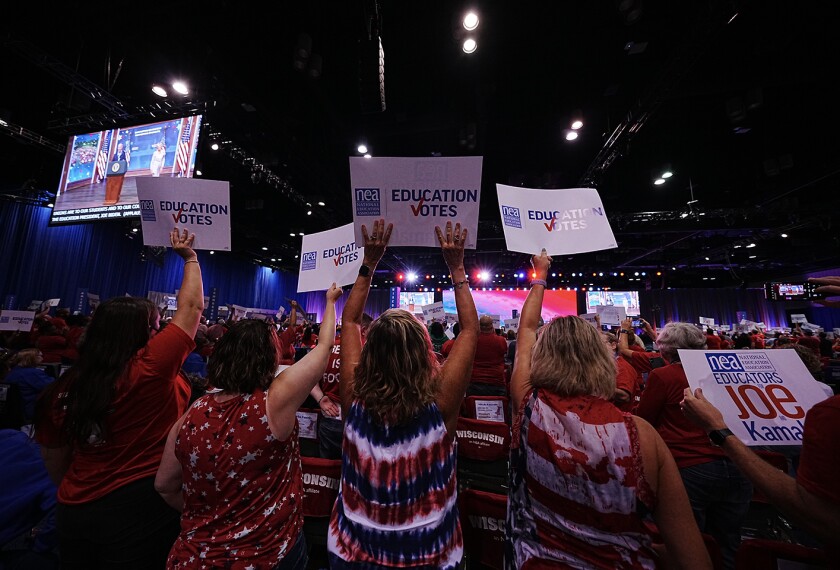Before heading back to the classroom to start the new school year, countless teachers will hit the mall, big box stores, and online shopping sites. They may or may not pick up new wardrobe staples and accessories for themselves.
But most public school teachers will spend a significant amount of out-of-pocket money on classroom supplies, an average of $673 per year, according to a recent survey of more than 1,100 educators by the Association of American Educators (AAE), a professional organization. While advocacy organizations including AAE are pushing for increased federal tax deductions to offset the amount that teachers spend on out-of-pocket expenses, some district leaders point to existing and sometimes untapped resources they say could help cover them.
“We certainly don’t want teachers spending their own money [on classroom supplies]. Knowing their good nature, they just do it,” said Wayne Workman, superintendent of the Lyon County school district in Dayton, Nev. “It’s incumbent on us as leaders to let teachers know that they have resources available to them.”
Tapping resources, from grassroots giving to corporate donations
Historically, local organizations such as churches have run school supply drives to support the needs in his rural district, Workman said. But in the past few years, the district has widened its net of support to include DonorsChoose, a 501(c)(3) not-for-profit corporation started in 2000 by former teacher Charles Best to support classroom projects.
Since its inception, DonorsChoose has vetted and granted over 2 million classroom project requests totaling $1,501,384,947 via the support of citizen donors, according to its website. Workman estimates that his district, in the past few years, has received between $40,000 and $50,000 worth of products from the organization for its classrooms—everything from basic classroom supplies like crayons to materials for robotics programs.
Increasingly, districts are taking advantage of corporate-sponsored opportunities to fund student and classroom needs.
Last week during a back-to-school celebration, Ohio’s Columbus school district distributed 500 backpacks filled with school supplies to students at Georgian Heights Elementary School, a Title I elementary school in Columbus, courtesy of the ODP Corporation, which owns Office Depot and Office Max. This year, the corporation’s Start Proud! program will donate an estimated 18,000 backpacks with school supplies to more than 25 Title I schools nationwide, according to a news release. Also as part of the Start Proud program, Georgian Heights and other participating Title 1 schools will receive $20,000 in-store credit at Office Depot OfficeMax to be used for classroom essentials.
School-based funding is sometimes overlooked
Sometimes school or district funds that are budgeted for classroom supplies go under-utilized, say district leaders.
“What I think happens is that there’s a continual myth that schools are unable to provide these basic supplies,” Workman said. “For us, it’s been an education point [for administrators].”
Workman pointed to situations where principals end up with surpluses in their budgets at the end of the year. “We’ve tried to educate our administrators on how to better budget,” he said. “That budget is meant to be spent on kids this year.”
Other districts offer ways for teachers to purchase classroom needs using existing resources.
At Maine’s Gorham school district, for instance, teachers can use a direct purchasing account with Amazon for school-approved purchases. Additionally, teachers have access to school accounts at select big box stores to buy pre-approved classroom items, said Heather J. Perry, the Gorham superintendent.
A closer look at teachers’ out-of-pocket spending
Perry acknowledged that, even when schools provide resources to teachers, some will still spend their own money on classroom supplies.
“But I don’t think it’s because teachers have to, but because they want to,” she said. “They just think about the kids first.”
The AAE survey showed that many teachers—68 percent—who get funding from their schools still spend some of their own money on a range of supplies, including notebooks; pencils; food and snacks; prizes and birthday cards; classroom decorations; cleaning supplies; and basic necessities for students including deodorant, Band-Aids, and toothbrushes. Only seven percent of survey respondents agreed that, without their out-of-pocket purchases, students would have what they needed for academic success.
Further, the survey results found that teachers who can probably least afford it are spending the most on school supplies.
Teachers earning between $35,000 and $50,000 buy on average $715 worth of supplies with their own money. Teachers who work in high-poverty schools, where 75 percent or more students are eligible for free- or reduced-price lunch, also are more likely to spend higher amounts on supplies—an average of $761.
This confirms that educators spend relative to student need, said Colin Sharkey, executive director of AAE, which has been advocating since 2020 for an increase in the Educator Expense Deduction from $300 to $1,000.







